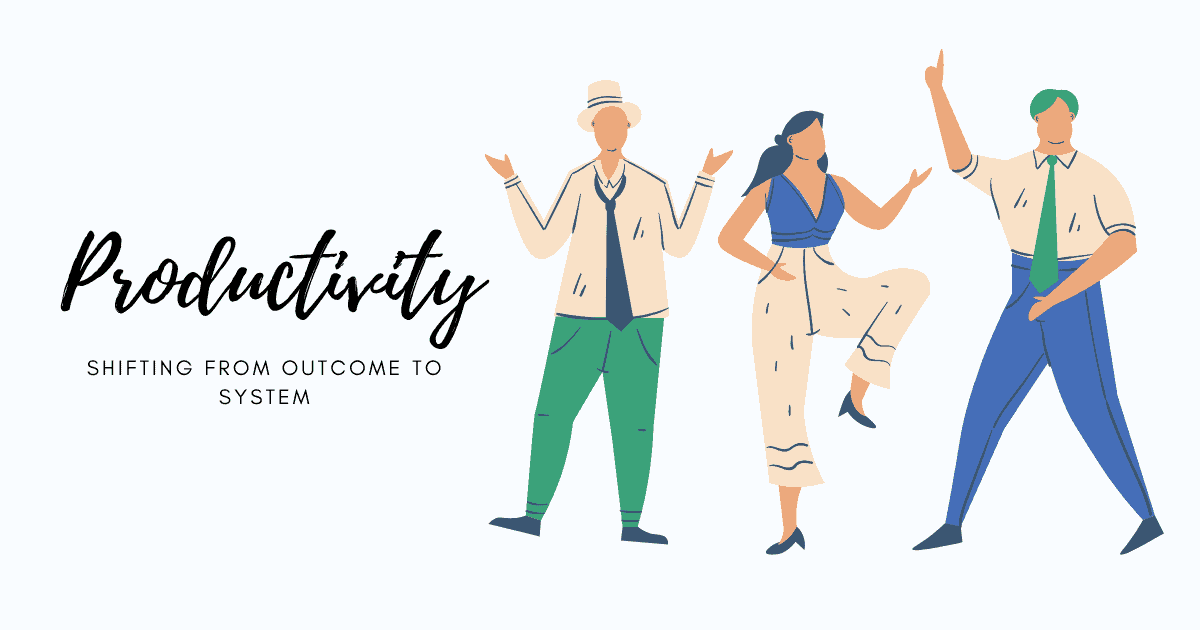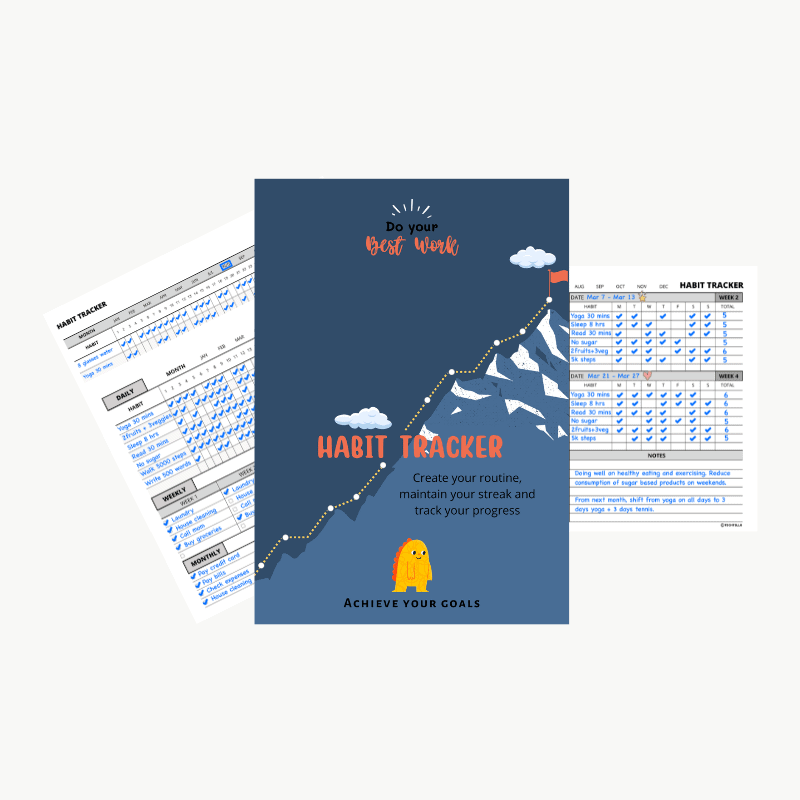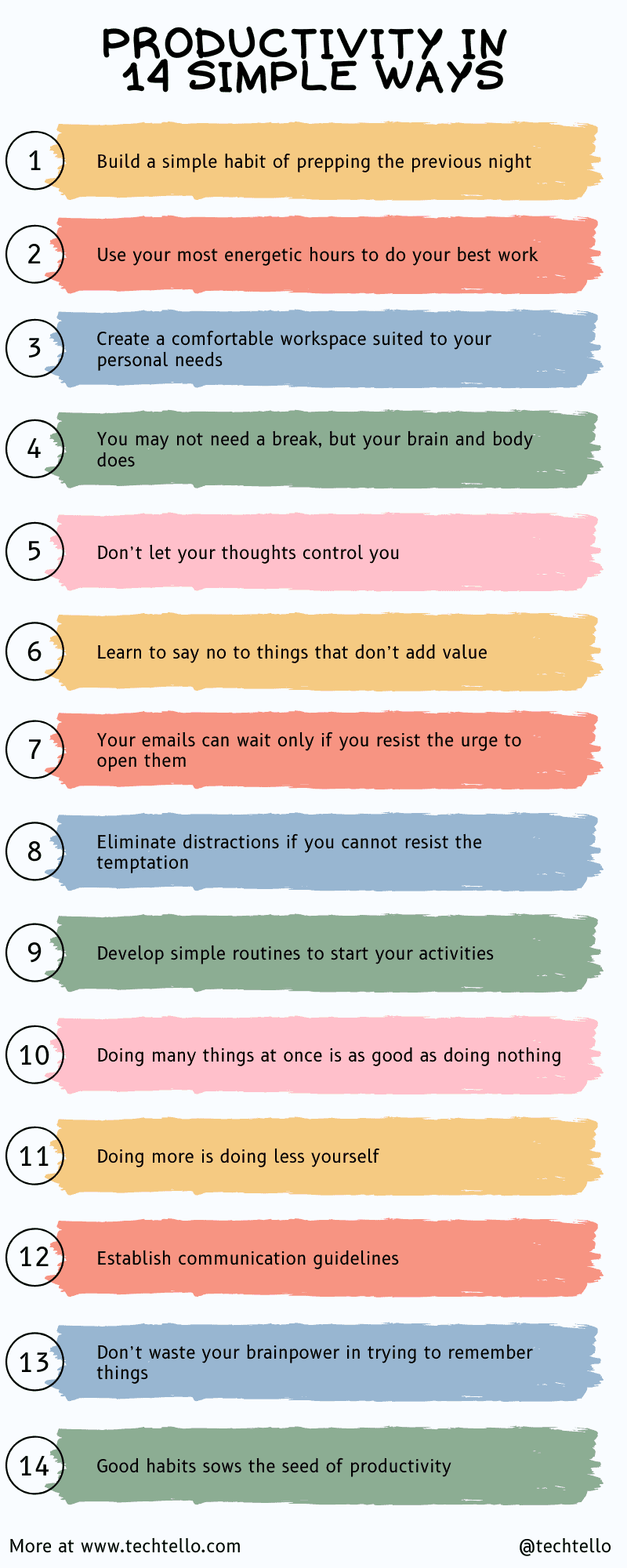Productivity: 14 Simple Ways To Be More Productive Everyday

Early in my career, I placed a lot of focus on doing more in less time. I thought I was being productive. The reality was I was simply scrambling from one task to the next without clarity on whether my work was effective or how I could do better. I focused on the end goal, the result I wanted to achieve without really caring about the process to get there.
Without being deliberate in my choices to do effective work and developing a process to do it efficiently, I achieved some short term goals. But, I struggled to find meaningful patterns that could advance me to achieve long term productivity.
With time, patience, and lots of learning along the way, I realised that doing more is actually doing less by focusing on things that matter and having a solid control over the process to achieve desired outcomes.
That’s when I discovered what productivity is all about.
What does it mean to be productive
In a simple form, productivity is developing a consistent and repeatable process that helps us do effective work more efficiently, where effectiveness is doing the right thing; work aligned with our goals and efficiency is doing it right; with fewer resources, time and effort.
Productivity demands shifting our focus from obsessing about the outcome to the system, the process to achieve that outcome. Once we can learn to take control of our systems, getting to the right outcome will be a byproduct of using the right systems.
Here are the 14 steps to being more productive that I have developed over years with a deep focus on the process.
How to master productivity in 14 simple steps
To improve productivity and achieve work efficiency, remember to “focus on the process”. This also means spending time on improving areas that are under your control as opposed to worrying about the impact of things beyond your control.
These 14 steps while independent build upon each other. Their power comes from small improvements done consistently over a period of time. By applying previous learnings and exploring new and better ways of doing things, their benefits compound over time freeing up more energy to do meaningful work with less effort.
It sets the motivation flywheel in action by doing and seeing tiny little progress in work that matters.
1. Build a simple habit of prepping the previous night

Spend a few minutes at the end of each day to prioritize what you want to accomplish the next day. It’s also extremely useful to divide work into chunks of different activities and outline a few bullet points on what you want to achieve in each chunk.
The simple act of writing things down not only boosts confidence by making us feel in control, it also frees our mind to actually get the work done and avoid reacting to urgent work as opposed to doing important work.
While prioritizing tasks, pick the ones which will move you in the direction of your goals while avoiding time-wasting activities that do not add value. Applying the Pareto principle, the 80/20 rule which states that 80% of results are achieved from 20% of our work is a good way to achieve optimal prioritization.
It’s also useful to employ the Eisenhower decision matrix for organising tasks in a 4 quadrant view for easy reference and prioritization.
Eisenhower Productivity Planner Worksheet
Organize your to-dos and clear out unnecessary tasks with the help of this powerful planner.
This answers the “What”. We also need to determine the most optimal time during the day for each activity, which brings us to our next step for determining “When”.
2. Use your most energetic hours to do your best work
Each work unit demands different physical and mental resources. Learn what kind of tasks need what kind of energy and organise for optimal utilisation by matching energy with physical and mental demands of work.
Use your peak productivity period to do some of your most important work. It could be morning, afternoon, evening, or night – whatever works for you. Different people work best at different times of the day.
I am an early riser and for me personally a few hours after I wake up is the best time to do deep work. Knowing deep work compounds over time, it’s best utilised in doing work that matters.
Now that we know the “What” and the “When”, we have established a clear intent. Achieving work efficiency and productivity requires turning it into action starting with creating optimal working conditions, but why?
3. Create a comfortable workspace suited to your personal needs
A lot of people do not realise that a wrong working environment as simple as a cluttered work desk can be a big source of stress and productivity killer. Designing a comfortable workspace is not intuitive and seldom explored because we learn to live with it.
I understand that not everyone is privileged to get the best working environment of their choice, but consciously making an effort to improve it, even in small ways can make a dramatic difference in the quality of your work.
Do you have comfortable seating, are you using the right headphones, does the temperature suit you, are you hydrated while working, do you sit humped back or straight up, is your desk too cluttered, are you wearing comfortable clothing?
Our mind gets easily distracted and annoyed under sub-optimal working conditions thereby impacting productivity and taking away our ability to focus. Take control of your surroundings by making a conscious effort to observe what around you diverts your energy or makes you uncomfortable to do your work. Then find ways to get rid of it.
Once you have the right working conditions, how do you achieve the right levels of thinking?
4. You may not need a break, but your brain and body does

At times when we are stuck at an impasse, a mental block to move forward, we get overwhelmed and anxious. The state limits our thinking to existing solutions and does not seek new ideas causing us to stop making progress or take too long to finish a task.
What do we do when we reach this state? Most of us continue working while feeling frustrated, annoyed and even angry with ourselves for not finding the right answers. Continuing to work when dealing with a mental block is not only less productive, it may lead to bad decisions with severe consequences in the future.
We experience new ideas or better ways of doing things when we are not actively thinking about them. Giving space to our brain to form new connections is essential to discover new solutions and get over an impasse.
Stand up, go grab a snack, get some fresh air, simply walk around without actively thinking about the problem. Great ideas will flow without making an effort.
As a practice, it’s very useful to recover and refuel our mind and body with a small break after every slot of deep work using pomodoro technique to re-energize and develop better levels of thinking for improved productivity.
Pomodoro Planner Bundle
Break down your big goals into small tasks, limit distractions and build focus with this planner.
Developing a better way of thinking is a great way to improve work productivity, but unless we also learn to control our thoughts we may waste a lot of time with automatic mind wandering and distracted thinking that breaks our flow of work. How can we learn to control our own thoughts?
5. Don’t let your thoughts control you
David Rock sums this up beautifully in his book Your Brain At Work
I decide to be responsible for my mental state instead of a victim of circumstances. In the instant that I make this decision, I start seeing more information around me, and I can perceive opportunities for feeling happier. This experience is one of finding a choice and making that choice, and it shifts what and how I perceive in that moment
The most important thing is to be aware that we all have the tendency to be carried away in thoughts and while it may seem they are beyond our control, we can learn to manage them with practice.
Consciously make an effort to catch yourself in the act and bring the focus back to your work. Our mind will not stop running this constant stream in our heads unless we learn to recognise it and take charge of it.
It’s good to feel powerful by learning to say no to our own thoughts. But, what about saying no to others? Isn’t saying yes to everything highly unproductive?
6. Learn to say no to things that don’t add value
Being productive demands saying no to work that does not align with your goals and mission. It’s not easy to say no, but it’s the only way to focus on work that really matters. Remember, productivity is not just doing the thing right, it is also about doing the right thing.
Once you get over your fear of saying no or desire of being liked, you will stop worrying about how your no may upset some people or how they might react. A carefully crafted no can enable both parties to engage in a more productive discussion and align on the outcomes.
There’s something else that can still derail you from your intended course. Emails?
7. Your emails can wait only if you resist the urge to open them

Emails can suck productivity if not managed well. Even one tiny peek can distract us from doing important work. The quick look is never really quick as the image of those emails in our mind leaves less room for doing meaningful work.
It’s best to not open emails till noon. Schedule a ½ or 1 hr slot before lunch and then another slot in the evening or end of day whatever works best for you. It does require a lot of self-control to do what you had planned the previous night and prevent the false sense of urgency from taking over your day.
If something is really urgent, people in the organisation will find a better means to reach out to you.
Emails managed. What other distractions can hamper your productivity?
8. Eliminate distractions if you cannot resist the temptation
Focused work requires time away from distractions. Checking social media, looking at your notifications, browsing the phone are time-wasting activities that can prevent you from achieving your goals.
Being aware of your distractions is the first step to removing them. If you are someone like me, adding a small friction can be a powerful way to block them out. I logout from all my social media accounts while doing important work. The simple barrier to provide login information prevents me from checking them too often.
One another strategy that works well for me is to schedule time to do these activities as part of my daily planning. Knowing that I have blocked time makes me more tolerant of the idea of not checking them out during my other planned work.
Implementation Intentions Worksheet
Develop an action plan to avoid distractions, stay on track and achieve your goals with this template.
Once we manage to keep all distractions away and actually get down to work, what’s the best way to get started?
9. Develop simple routines to start your activities
The anxiety from the unknowns in the task may prevent us from getting started – what if I am not able to complete on time, will I do it well, am I competent, what if others don’t like my work. The constant chatter in our mind even before we have started can prevent us from making any progress.
Breaking the barrier to getting started requires motivation. It doesn’t come from waiting for the right time or the right idea to click. Motivation is in small acts that move us in the direction of our goals.
Establishing routines can activate patterns in our brain which can overcome the mental block to begin. For my writing, I always begin by outlining key points for a new article or read what I wrote the previous day. This simple act kicks in the motivation to continue and do more.
Identify what routines work for you and use them as a hack to get started.
Ultimate Habit Tracker
Use this habit tracker printable template to record your daily, weekly and monthly habits and see how you are progressing.
Once you actually get down to work, can you shift between multiple tasks and still be productive?
10. Doing many things at once is as good as doing nothing

For important activities that require deep thinking, we need to have the mental discipline to focus on that task alone. Doing many things at once convolutes our brain with too much information preventing it from generating useful insights to get the work done.
Shuffling constantly between tasks may be a great excuse for leaders and managers to keep busy, but without learning to manage their time, they cannot do work that will advance their organisation and its people.
A useful trick that improves productivity is to schedule similar activities one after another. It enables much faster progress as learning and inputs from the previous activity feeds directly into the new tasks without requiring extra mental effort to form new connections.
For instance, if I have to write job descriptions and create a pitch for hiring strategy, I prefer to schedule job descriptions right after developing a hiring strategy. The inputs from the hiring strategy can then be directly applied to writing job descriptions.
Once we learn to discipline our minds to focus on one task at a time, we also need to discipline our minds to give up the urge to do everything ourselves.
11. Doing more is doing less yourself
There are multiple benefits of delegation – achieving scale, building trust, and empowering others. Productivity just happens to be a side effect of making the right choice to delegate. Focus on what you can do best and delegate everything else.
Delegation is not easy and can be effective only if you set clear expectations and align on the outcomes. Initially, it may seem like a lot of work and your mind may tempt you to do it yourself, but you can learn to give up the temptation in favour of achieving long term productivity.
As you learn to delegate more, you will get ample free time on your hands to do things that matter.
It’s also not wise to engage humans in doing work that can be achieved through automation. Technology has enabled some beautiful solutions. Identify what part of your repetitive work can be automated and make the best use of technology to automate them.
Setting up your own productivity routine is great, but will it work without cooperation from others?
12. Establish communication guidelines
If your work demands communication and collaboration with others, you cannot be productive unless you establish communication guidelines with them. Without the knowledge of what’s the best way to reach out to you or when others may continue to interrupt you during your most productive hours.
Define the medium to use for different kinds of issues (email, phone, chat) and broadcast blocks of time when you will be available to answer queries, help co-workers, or whatever else your work demands.
Plan the unplanned work by consciously dedicating a few hours in a day to avoid reacting every time someone comes up with an ask.
You may have a great memory, but it’s not the best use of your mental resources to try to remember everything.
13. Don’t waste your brainpower in trying to remember things

Our brains can’t hold too much information at the same time. Keeping the mental stage free for processing information that needs it is the easiest way to improve productivity.
The best way to keep yourself organised and do the right things at the right time is to schedule your responsibilities – send calendar invites, set up reminders.
Scheduling also saves energy by removing decision making from the process. Once it’s on your calendar, you don’t need to decide anymore.
This is the beginning to unleash your full potential.
14. Good habits sows the seed of productivity
Good habits are the key to unlocking your maximum potential. Examine what habits energize you and which ones contribute to your inefficiency. Unless you learn to change your habits, you may get the work done, but it will be far less than what you are capable of.
Learn more about yourself – healthy eating, sleeping well, constant learning are some of the most basic needs for a healthy mind and body. Also, doing what you really enjoy even if for a small duration every day can renew your focus and unleash creative outflow.
Once you shift your mindset to focus on the process and not the outcome, you will find new and creative ways to be more productive every day.
Remember, the 3 Ps – Productivity with focus on the Process and Persistence to improve.
Do you have any productivity tips that help you to be more productive every day? Write to me or share it in the comments below.




































Awesome article! Really loved the content.. keep up the good work 🙂 .
Thanks Sawan. Appreciate you taking the time to read it and share your feedback.